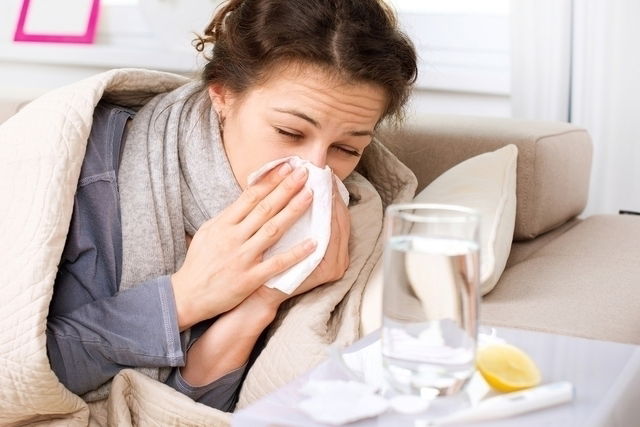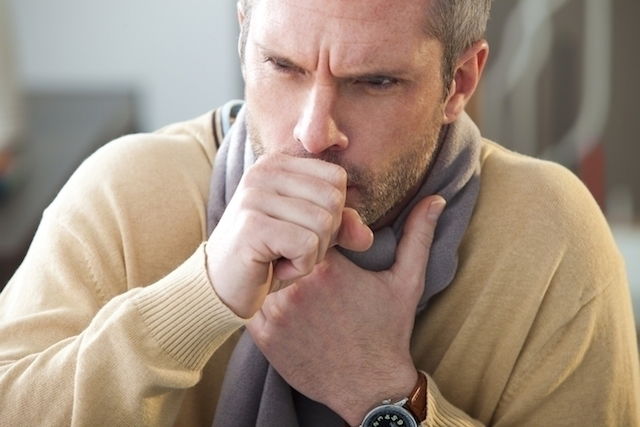Common cold symptoms usually appear 1 to 3 days after initial infection by a virus that causes colds, like a rhinovirus. These viruses are transmitted through droplets that remain suspended in the air after an infected person coughs, sneezes or blows their nose.
The common cold is most frequently experienced during fall and winter seasons, as people are more likely to stay within closed environments for longer periods of time.
Cold symptoms can often be treated at home with simple measures, like plenty of rest, fluids and throat gargles. However, more intense symptoms, like headaches or persistent coughs, can be managed with over-the-counter medications.

The main symptoms of a common cold are:
- Runny nose, with a clear, watery discharge
- Stuffy nose
- Yellow or green.tinged phlegm
- Sneezing
- Sore throat
- Coughing
- Body aches
- Mild headache
- Low-grade fever
- General malaise
Usually, these symptoms appear gradually and last for about 7 to 10 days. However, smokers often experience these symptoms for even longer. If you symptoms do not seem to improve, or if you have a fever over 38.5ºC (or 101.3ºF), you should see a doctor for assessment.
Cold vs. flu
The main difference between a cold and a flu is the intensity of symptoms. With the flu, symptoms are often more severe and fevers are usually much higher. Symptoms will also persist for longer with the flu and are overall harder to treat. Read more about the difference between a cold and a flu.
How to relieve symptoms
Common cold symptoms can easily be treated at home, through simple measures like:
1. Drinking plenty of water
Maintaining adequate hydration levels is essential for recovering from a cold. Drinking water also helps to thin-out discharge and help with elimination. This can help discomfort from a runny or stuff nose. You should aim for about 8 cups of fluid per day, which can be consumed as fresh juice, tea, broth or water. Learn about other ways you can clear a stuffy nose naturally.
You should avoid consuming caffeinated drinks, like coffee or black tea, and alcohol, which can cause further dehydration.
2. Resting
Rest is very important for optimal functioning of the immune system to combat an infection. Resting will lead to a quicker recovery and reduce chances of transmitting the virus to others.
When recovering from a cold, you should stay home from school or from work to rest, particularly if you have a fever, intense coughing or drowsiness.

3. Using a humidifier
Using a humidifier helps to increase moisture in the air and help relieve nasal congestion and coughing. Another easy way to increase moisture in the air is by placing a bowl of water in the living room or bedroom, where the infected person is resting.
4. Gargling warm water and salt
Gargling with warm water and salt can help to relieve a sore throat and get rid of phlegm. The salt is a natural antiseptic that can help to kill bacteria contributing to the infection.
To perform a throat gargle, add half a teaspoon of salt to a half cup of warm water. Gargle the mixture for a few seconds and spit it out. Check out other ways to relieve a sore throat with over-the-counter medications and home remedies.
5. Nasal irrigation with saline
Irrigating the nose with saline water can help to relieve nasal congestion and remove discharge that is trapper inside the upper respiratory tract. It is also a great way to prevent sinusitis. One way to relieve nasal congestion in babies and children is to aspirate nasal secretions with a bulb or syringe after inserting saline solution. Read out step-by-step guide on how to perform a nasal irrigation.
Treatment options
Cold symptoms often improve within a few days without any specific treatment with medication.
However, the doctor may recommend medications to help manage specific symptoms and discomfort associated with a cold, like:
- Analgesics or anti-inflammatories, like acetaminophen or ibuprofen, to treat fever, sore throat, headaches, or body aches
- Decongestant nasal spray, to relieve nasal congestion. Adults should not use nasal sprays for longer than 5 days.
- Expectorant cough syrup, like ambroxol or guaifenesin, to help with respiratory secretion elimination.
- Mucolytic cough syrup, like acetylcysteine or bromhexin, to help thin-out secretions and help with their elimination.
- Antihistamines, like loratadine, to help open up the airways and relieve congestion and sneezing.
It is also important to boost your natural defense mechanism, which is your immune system. You can do this by incorporating more foods that are rich in vitamin C into your diet, like oranges, pineapple, strawberries and cherries.
When to see a doctor
Although it is not always necessary to see a doctor every time you have a cold, you should seek medical attention if you present with any of the following symptoms:
- Fever over 38.5ºC (101.3ºF), or a fever that lasts for over 5 day, or a fever that returns after it had resolved
- Fever of 38ºC (100.4º) in newborns up to 12 weeks of age
- Fever that increases in temperature or lasts for more than 2 days in children of any age
- Worsening of symptoms
- Gasping for air
- Severe sore throat
- Ear ache
- Headache
- Sinus pain
Children who are very confused, drowsy or without appetite should also be assessed by a pediatrician so that the most appropriate treatment can be initiated
